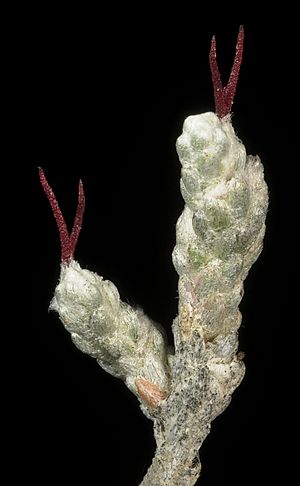Saltmat
Quick facts for kids Saltmat |
|
|---|---|
 |
|
| Conservation status | |
| Scientific classification | |
| Genus: |
Roycea
|
| Species: |
pycnophylloides
|
Roycea pycnophylloides, also known as Saltmat, is a special kind of shrub. It only grows in Western Australia. This means it is endemic to that area. It's a unique plant with no other scientific names.
What is Saltmat?
Saltmat is a perennial plant, which means it lives for many years. It grows as a silvery, bushy mat that can spread up to 1 meter wide. Its branches are covered in a soft, woolly fuzz.
The plant has tiny leaves, about 2 millimeters long and 1 millimeter wide. These leaves are fleshy and overlap each other, like scales on a fish. When they are young, they feel very silky.
Saltmat Flowers
Saltmat is a dioecious plant. This means it has separate male and female plants, each with different flowers.
- Male flowers: These flowers are shaped like small cups. They have thin, oval-shaped tepals (petal-like parts) that are about 1 millimeter long. The outside of these flowers feels silky. The male parts, called anthers, stick out.
- Female flowers: These flowers are about 1 millimeter long. They do not have male parts. The female parts, called stigmas, are long (about 4 millimeters) and also stick out.
After the female flowers are pollinated, they produce fruit. The fruit is round or egg-shaped, about 2 millimeters tall. It is surrounded at its base by the flower parts that stay on the plant.
Where Saltmat Lives
You can find Saltmat growing near the Mortlock River in southern Western Australia. Specifically, it grows close to the town of Meckering.
It likes to grow on flat, sandy areas around the river. The soil in these areas is often a bit salty, which is why the plant is called "Saltmat."



